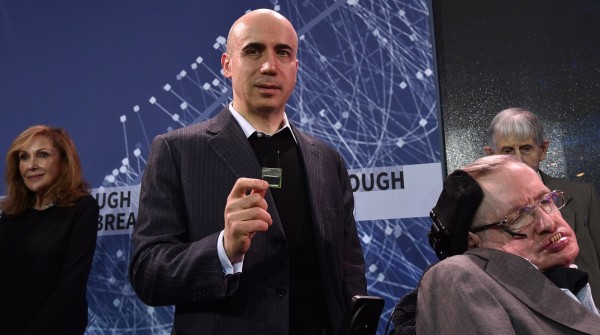By Ana Verayo, | April 13, 2016

Yuri Milner and Stephen Hawking pose with a new chip as they host press conference to announce Breakthrough Starshot, a new space exploration initiative, at One World Observatory on April 12, 2016 in New York City.
Send tiny spacecraft via lasers to reach a distant star system? This will soon become a reality carried out by an ambitious US $100 million plan to develop space technology for tiny spacecraft to be transported to the edges of the cosmos, in order to discover intelligent life in the universe where humans have never ventured to to search in.
Like Us on Facebook
Known as the Breakthrough Starshot project, internet magnate and Russian billionaire Yuri Milner along with famed physicist Stephen Hawking and Facebook founder Mark Zuckerberg announced this promising space venture yesterday.
According to chairman Avi Loeb from the Department of Astronomy in Harvard University, this is similar to the Apollo lunar mission in the 1960s, as to having a vision to accomplish something unusual and extraordinary, who will also be managing Starshot.
The ultimate goal is to send thousands of spacecraft or probes, so tiny, that they weigh less than an ounce, towards the nearest star system, Alpha Centauri, which is estimated to be 2,000 times farther than any human made spacecraft has ever gone before.
The journey alone may take some 20 to 30 years, where Loeb adds that the very first close up images that will be transmitted back to our planet could reveal the most mind blowing discoveries about the evidence of intelligent life. Loeb says, this is my hope and the best scenario here is to discover other things that we have never anticipated or dreamt about.
The tiny, lightweight spacecraft will be propelled by an array of powerful lasers that will be generated from Earth, where the probes will be travelling in one fifth the speed of light. Upon launching, the spacecraft will sit atop a rocket and will be released in lower Earth orbit to be captured by energy set by the earthbound laser array.
Milner says, we can do so much more than gaze at the stars, and now we will finally reach them. According to planetary science professor, Sara Seager from the MIT, who also advised Milner and other projects, this massive space venture can attract more experts and backers to develop the revolutionary technology required for the Starshot mission.
Seager also says that people have been thinking about space travel to the nearest star system for a long time, however, no one has made an actual plan to do something about it, which means that Breakthrough Starshot is an incredibly ambitious and very inspiring mission for humankind.
To date, astronomers are still not certain if the Alpha Centauri system contain planets. There is one exoplanet identified near the star however, this also does not seem to be habitable since it is too hot.
According to professor Kerri Cahoy of the Space Systems Laboratory at MIT, this mission will require several research efforts to support Starshot's goals, where some of the work are already under development. She adds that for laser beams to propel and catapult a tiny spacecraft, they are needed to be extremely narrow as it will be challenging enough to also develop similarly small transmitters and receiver systems. Cahoy also says that this will certainly take a significant amount of investment to complete this goal but it is still feasible to work towards this.
-
Use of Coronavirus Pandemic Drones Raises Privacy Concerns: Drones Spread Fear, Local Officials Say

-
Coronavirus Hampers The Delivery Of Lockheed Martin F-35 Stealth Fighters For 2020

-
Instagram Speeds Up Plans to Add Account Memorialization Feature Due to COVID-19 Deaths

-
NASA: Perseverance Plans to Bring 'Mars Rock' to Earth in 2031

-
600 Dead And 3,000 In The Hospital as Iranians Believed Drinking High-Concentrations of Alcohol Can Cure The Coronavirus

-
600 Dead And 3,000 In The Hospital as Iranians Believed Drinking High-Concentrations of Alcohol Can Cure The Coronavirus

-
COVID-19: Doctors, Nurses Use Virtual Reality to Learn New Skills in Treating Coronavirus Patients







